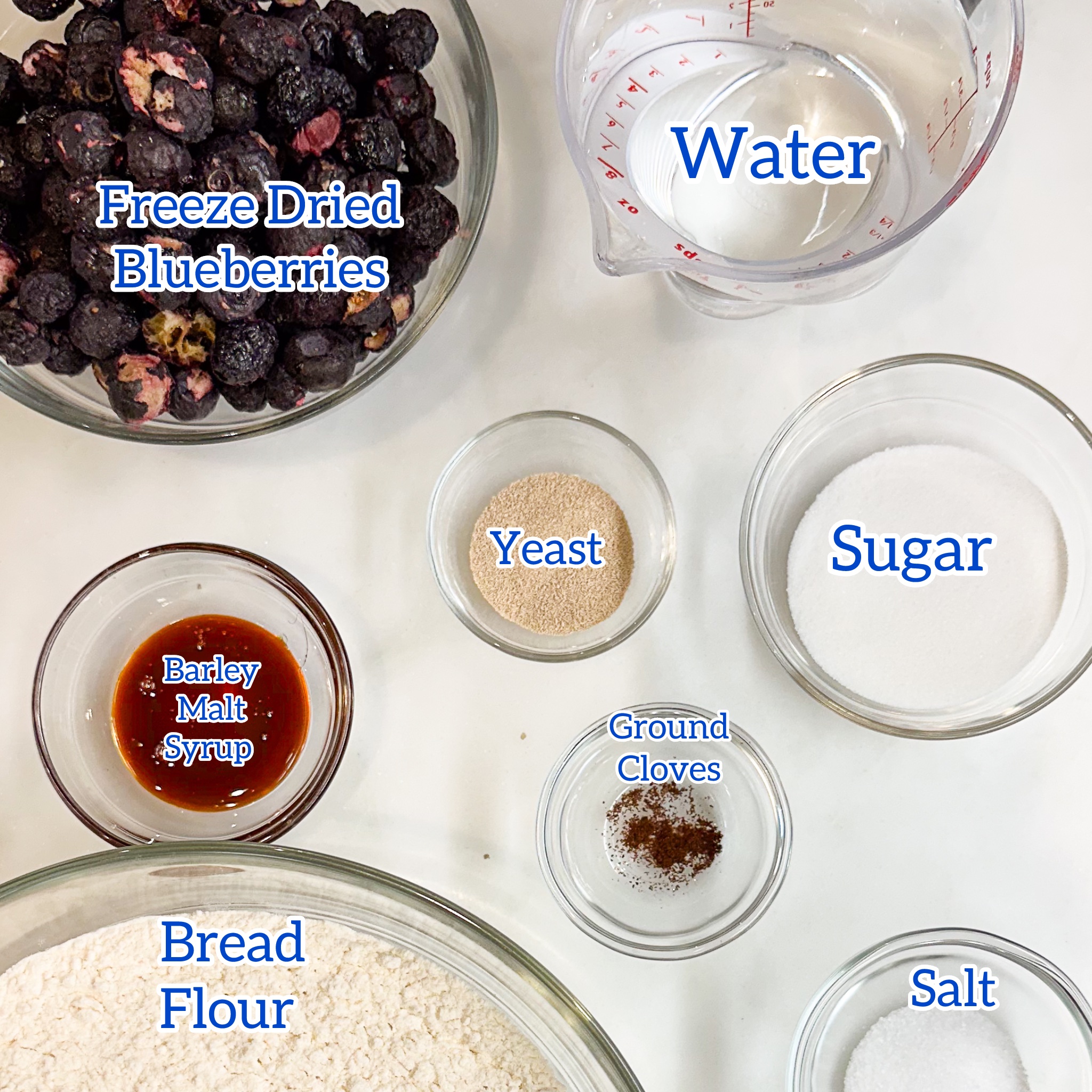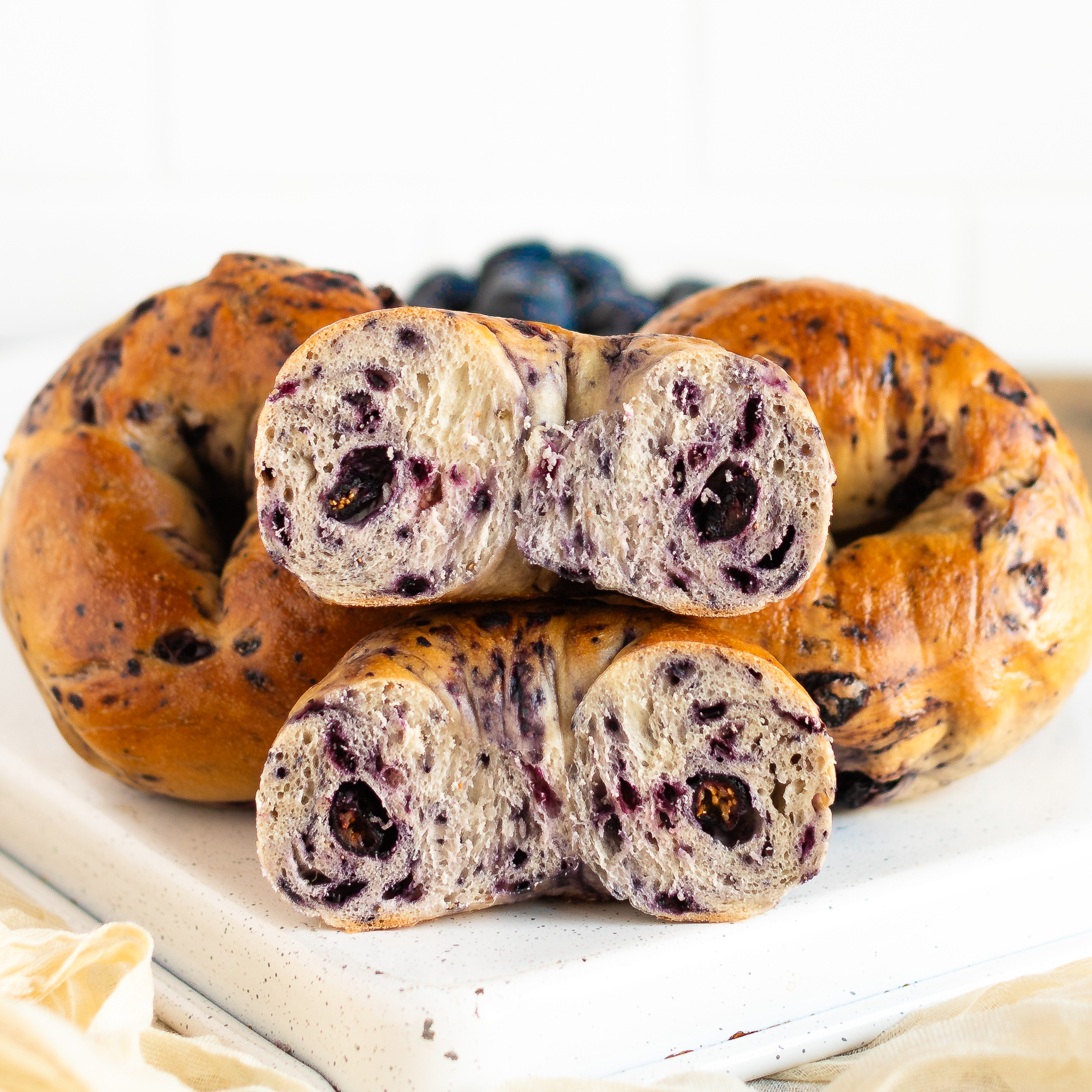This post may contain affiliate links. As an Amazon Associate, I earn from qualifying purchases. For more information, please visit my Privacy Policy.
Controversial, yet delicious. These New York Blueberry Bagels are pretty, delicious and fun to make. Using my traditional New York Bagels recipe, this recipe cranks out the best Blueberry Bagels out there. Trust me, I have sampled tons of blueberry bagels out there, and I worked on this recipe off and on for a couple of years.
What is a New York Bagel?
When making a New York Bagel or a New York style bagel, I insist on including one critical ingredient: malt. I have said it before and I’ll say it again: A true New York bagel requires (yes, I said it: requires) malt, whether in syrup or powder form. Malt is essential, whether in homemade bagels or store-bought.
What is Malt?
Malt is a sweet derivative of roasted barley. In this recipe (and most bagel recipes), we use non-diastatic malt, which means that the malt was heated to the point of killing the enzymes contained in it. Diastatic malt therefore has active enzymes in it and is used in bread recipes to assist with rising and conditioning the dough. Non-diastatic malt, which is more commonly used in bagels, simply provides a touch of sweetness and deeper color in the bagels without affecting the rise or dough consistency.
Malt is not a key ingredient in this recipe in terms of the structure of the bagel. It is, however, a key ingredient in terms of flavor. There are recipes out there that use “substitutes” for malt such as molasses and brown sugar. Those bagels may come out good, but they are not (I repeat NOT!) true New York bagels.
Non-diastatic malt comes in two forms: powder or syrup. The advantages of using powder are that powder has a much longer shelf life, can be stored at room temperature, and is much easier (i.e., less messy) to use. The con of using malt powder is that it seems to not be as readily available. I buy mine online at King Arthur Baking Company and sometimes on Amazon.
Barley malt syrup can be found on store shelves, usually at Whole Foods. I like using the syrup because I think it imparts a darker color to the bagels. I dislike using the syrup because it is very messy. Also, because the syrup has a more limited shelf life once opened, if I don’t plan on making bagels too often, I prefer the powder to avoid waste Check labels, but barley malt syrup is generally non-diastatic. That said, I have been using barley malt syrup exclusively for the past year.
Can I Use Substitutions?
Remember: a substitute is just that. It is a second-best replacement for an ideal ingredient. If you are going to take the time and energy to make something, don’t you want it to be the best? I do. So, if you are going to make these New York Blueberry Bagels, plan in advance and buy the barley malt syrup or the non-diastatic malt powder. If you do not want to buy the malt, I suggest you make a different bagel recipe.
Ingredients to Make Blueberry Bagels

Here is what you need to make the best Blueberry Bagels out there:
- Yeast. You can use active dry or instant yeast. I prefer instant yeast, as it is much easier to work with.
- Water. Warm water is key. Be sure to follow the instructions for whatever brand of yeast you use. I use Red Star instant yeast, and they recommend heating the water to approximately 120° F.
- Sugar. Sugar adds a touch of sweetness, aids in the exterior browning, and feeds the yeast.
- Bread Flour. Bread flour is ideal for bagels, providing deep gluten development for the best chew. All purpose flour just does not cut it here.
- Ground Cloves. I add ground cloves to just about everything I make with blueberries. They just enhance the blueberry flavor so well. Just a small pinch is all you need though, as ground cloves can be strong. By small pinch, I mean less than an ⅛ teaspoon. Adding ground cloves is entirely optional.
- Malt. As explained above, malt is a key ingredient in a New York bagel.
- Salt. Adding flavor and assisting the yeast in the dough’s development, salt is a key component in any bread recipe.
- Freeze Dried Blueberries. It took me many tries of fresh blueberries, frozen blueberries, and dried blueberries to realize the magic of freeze dried blueberries in bagels. My go-to has been the freeze dried blueberries from Nuts.com, mostly because they sell them in 2 ounce packages which is the amount I like in this recipe. I also like the Natierra brand, which I find at Whole Foods and Amazon.


Tips for Making Blueberry Bagels
Although bagels are actually quite easy to make, a few tips can make life easier for you:
- Use a mixer. I use my Kitchen Aid Professional 5 quart mixer. I am able to double this blueberry bagel recipe without an issue. The Artisan model may overheat and stop part way through. If that happens, just continue kneading by hand. However, be aware that kneading bagel dough by hand is an enormous workout.
- Knead the dough until it passes the windowpane test. The windowpane test means that you take a small piece of dough, flatten it out with your fingers, and gently pull the dough. If the dough pulls without ripping to the point where it is very thin and translucent, it has passed the windowpane test. If it rips easily, continue kneading, checking for the windowpane test after another minute.
- Shape. As you portion the dough, keep it covered with plastic wrap to prevent it from dying out. The freeze dried blueberries may try to pop out. Just work them back into the dough, trying to avoid having too many on the outside of the bagels.
- Refrigerate overnight. This is an important step. While you could let the bagel dough rise a bit at room temperature, placing them in the refrigerator overnight allows them to ferment slowly, developing a deeper flavor. Plus, you get fresh made bagels for breakfast!
Be sure to check out my other bagel recipes:
- Bagels (Be sure to check out my Everything Seasoning for these!)
- Cinnamon Raisin Bagels
- Egg Bagels
- Stuffed Onion Bagels
Frequently Asked Questions About Making Blueberry Bagels
Do I have to use malt to make bagels?
To make a true New York Bagel, there should be malt. If you do not have malt or do not want to buy malt, this is not the recipe for you.
What type of blueberries are best for Blueberry Bagels?
Freeze dried blueberries work best for blueberry bagels. Fresh or frozen blueberries add hydration to the dough and tend to turn the dough entirely blue. Dried blueberries lack flavor.
Can I double this New York Blueberry Bagel recipe?
Yes, you can easily double this recipe to get a dozen bagels. However, depending on the type of electric mixer you have, you may have to knead the dough by hand. A more powerful mixer like the KitchenAid Professional series can handle kneading a double batch of this recipe. The Artisan series will not and kneading that much dough could damage the motor.

Blueberry Bagels
Ingredients
Bagel Dough:
- 3 grams active dry or instant yeast
- 235 grams water
- 25 grams sugar (divided, if using active dry yeast)
- 455 grams bread flour
- small pinch ground cloves (optional)
- 20 grams non-diastatic malt powder, plus approximately 2 Tablespoons for water bath (if using barley malt syrup, use 10 grams in the dough and 1 Tablespoon for water bath)
- 10 grams salt
- 57 grams freeze dried blueberries (2 ounces)
Instructions
- In a mixing bowl fitted with the dough hook, combine the yeast, water and approximately 1 teaspoon of the sugar. Gently stir to hydrate the yeast. Allow to sit until foamy, 3-5 minutes. (If using instant yeast, add it with the rest of the ingredients in the next step.)
- Add the bread flour, ground cloves (if using), rest of the sugar, and 20 grams malt powder or 10 grams barley malt syrup. (If using instant yeast, also add the water.) Knead on a medium-low speed for about 7 minutes. Then, with the mixer on a low speed, slowly add the salt. Once combined, increase the mixer to medium-low, and continue kneading an additional 3-5 minutes. The salt should be fully absorbed (you should not feel the salt when you touch the dough) and the dough should be very smooth.
- To make sure the gluten is fully developed, do a windowpane test. Take a small piece (approximately 1 teaspoon) of dough and stretch it between your fingers. It should form a “window pane”, meaning it should get thin enough that it is translucent without ripping. If it is not at that point yet, continue kneading in the machine at 1 minute intervals or knead by hand until it passes the test.
- Knead in the freeze dried blueberries in small batches. You may need to turn the mixer off and move the dough around in order to fully incorporate the blueberries.
- Divide the dough into six equal portions, each approximately 130 grams (If you want your bagels to each be equal, weigh the full entire dough and divide the weight by 6 for the total number of bagels.) Shape each one into a ball, pushing the blueberries into the dough. Cover each ball with plastic wrap as you continue to form balls.
- Taking one dough ball at a time, flatten the ball with your fingers into an oval/rectangle, approximately four inches by six inches, so that the long part of the oval/rectangle is horizontal in front of you. Roll the dough up like cinnamon rolls. With the palms of both your hands, roll the dough against the countertop into a rope, approximately 8 inches long. Cover with plastic wrap. Repeat with remaining dough balls. Allow the six ropes to rest for 15 minutes.
- Attach the ends of each rope to form bagels, gently pinching the ends together. Place each bagel on a baking sheet lined with parchment paper. Place the tray, tightly covered in plastic wrap, in the refrigerator overnight.
- In the morning, remove the tray from the refrigerator and allow the bagels to come to room temperature, approximately one hour.
- Approximately 30 minutes before you plan to boil the bagels, preheat the oven to 425° F. Line a baking sheet with parchment paper and set aside.
- Using a pot large enough to comfortably hold 2 or 3 bagels at a time, bring a pot of water with 2 Tablespoons of non-diastatic malt powder (or 1 Tablespoon barley malt syrup) to a boil. (I use a 4½ quart pot and fill it up approximately half way with water.) Place 2 or 3 bagels at a time into the boiling water for 30 seconds. (See note, below, if the bagels are sticking to the parchment paper.) Flip each bagel and boil for an additional 30 seconds. Using a strainer or a slotted spoon, remove each bagel from the water and place the prepared baking sheet. Repeat with the rest of the bagels.
- Bake the bagels for 16-20 minutes, until the tops are browned.
Notes
- Some people spread corn flour or semolina flour on the parchment paper before placing the bagels on the baking sheet before refrigeration to prevent the bagels from sticking to the parchment paper. If the bagels stick to the parchment paper just prior to boiling, I prefer to avoid the additional mess and instead just cut the parchment paper into squares (each square holding a bagel) and boil the bagels with the parchment squares on them. After a few seconds in the boiling water, you can easily remove the parchment with tongs.
- Once baked and cooled, the bagels can be stored in the freezer for months. I recommend slicing them before freezing. To defrost, wrap each bagel individually in foil, place in cold oven, and turn oven on to 350° F. Within a few minutes of your oven reaching 350° F, your bagels should be defrosted and nicely warmed, begging for butter or cream cheese to be shmeared all over them.


5 Comments
I love bagels, especially blueberry bagels. I have yet to attempt to make them from scratch. I love baking bread, so now it is time to experiment with bagels too.
What a treat homemade bagels are….and this blueberry flavor was fabulous. Thanks for all your expert tips….this was my first time making bagels and it was so easy. Delish!
I’ve always wanted to make homemade bagels. Great tip on the freeze-dried blueberries!
Great bagels. We totally enjoyed fresh bagels for breakfast.
Delicious Blueberry bagels . Homemade bagels are best I like that you made with freeze-dried blueberries.